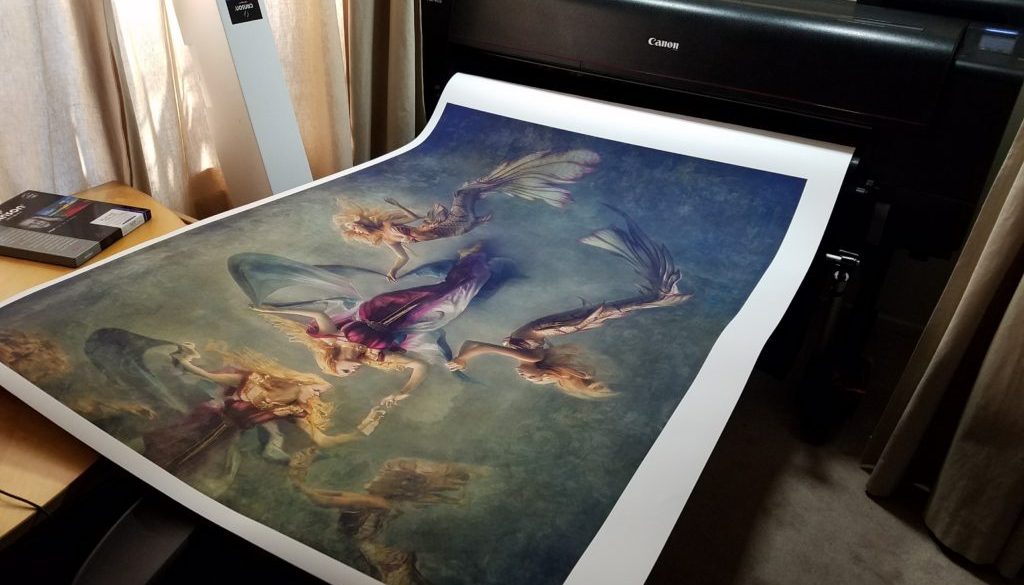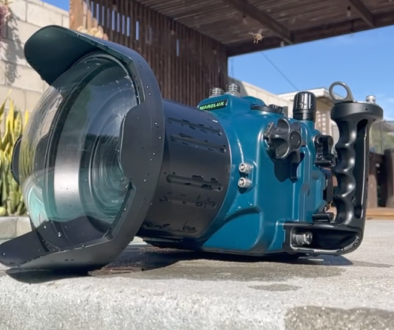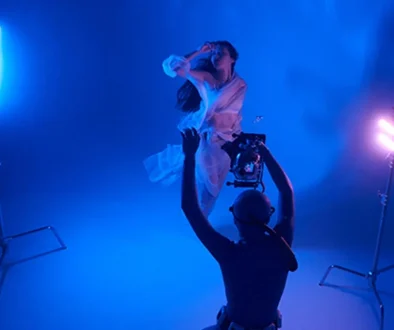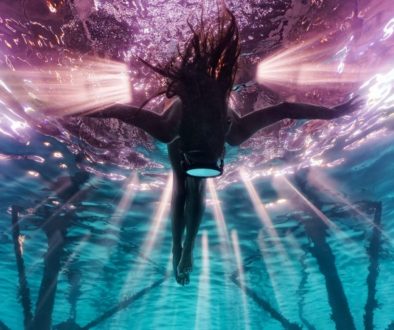Printing Your Underwater Photography
In my 15 years as an underwater photographer, the experience of being in the water with its calm, quiet, dark, visually beautiful, and weightless environment is something I crave so much. There is no doubt that many, if not most of my fellow underwater photographers participate in this complicated endeavor for that same love of being in the water.
I’ve asked many underwater photographers “What do you do with your images?” The answers range from people sharing their images, giving them away as gifts, selling them commercially, or as prints, or even NFTs. But what do you do with them for yourself, as an artist? How do they bring you personal joy?
The Photograph
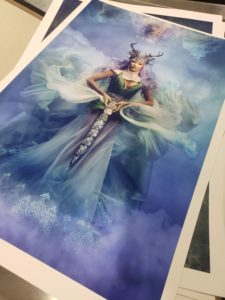 Some of us finesse the digital images on our computers, to perfection, with hours of color correction, retouching, sharpening, compositing and more. Then we put them out into the world on social media and websites. And there they stay, as digital artwork, being shared on a screen.
Some of us finesse the digital images on our computers, to perfection, with hours of color correction, retouching, sharpening, compositing and more. Then we put them out into the world on social media and websites. And there they stay, as digital artwork, being shared on a screen.
The physical fine art print is one major aspect of underwater photography where I feel we have been short changed. The majority of underwater photographers I’ve talked to have either never had their work printed or were so disappointed with their prints that they haven’t had them printed again. Maybe they were printed on the wrong substrate?
Experiencing a perfectly executed, color accurate, finely detailed, high resolution fine art print of your own artwork on just the right paper is life changing. I’ve seen grown adults reduced to tears (myself included) when holding the first fine art print of their own image. I have never seen that from someone looking at a screen.
Printing
While there is an abundance of information on the internet about photography, there is very little accurate information on digital inkjet printing, and being a self-described, lifelong paper nerd, I have printed on, researched, and inspected literally hundreds of different inkjet papers, from dozens of companies from around the globe.
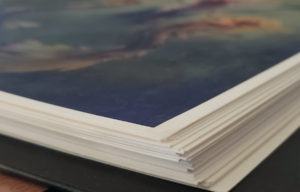
My journey led me to the authority in paper manufacturing, with a very long history and legacy in the industry, Canson Infinity. They combine well recognized and respected art papers and the most modern, advanced inkjet coating technology which places them as the leader in the industry – and as a Canson Infinity global Ambassador, I want to share with you my deep of love the fine art paper print and why.
Printing Underwater Images
I find underwater images unique in that their sharp edges and shadow detail are hard fought for and that color accuracy is at the discretion of the photographer. We took the time to create the work, we should decide exactly what it looks like on a piece of paper. Color shifts and muddy shadows should never be tolerated in prints. And we deserve to have prints that will last for as long as possible. There’s little point in a beautiful print that will fade in 5 year’s time. Finding the right substrate to print on is critical to having our vision brought to life. There are many options and I’m going to offer alternatives to what you might have seen, tried, or had suggested to you.
Chromogenic Prints
Inexpensive chromogenic “photographic” lab prints that are readily available at places like Costco, Walmart, WHCC, Millers or Bay Photo, are not the same quality as a “giclee” (I despise the word “giclee” and think it should be removed from our vocabulary, but unfortunately it’s still quite common), or pigment inkjet print. The process of creating a “photo” print is quite different from inkjet, as is the low resolution, lack of color accuracy and lack of archival qualities. They are dye based inks of a limited color range on plastic paper. We’ve all seen the very distinctive look of prints from the 60s, 70s, and 80s with their massive color shifts and fading. Chromogenic prints made today are done in a similar fashion and will fade and shift over time as well.
Prints on Metal, Acrylic, Canvas and Paper
Metal
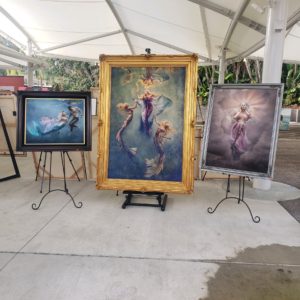 If I had a dollar for every time someone has suggested to me that I print my work on metal or acrylic I would certainly have a lot of money. The truth is that most of the information we see on these products is in the form of marketing materials from the labs that create them. There are very specific benefits to metal and acrylic. Their super glossy finish can give them the appearance of high contrast and saturation. The fact is that both metal and acrylic prints are decorative products that are low resolution and are not long-lasting.
If I had a dollar for every time someone has suggested to me that I print my work on metal or acrylic I would certainly have a lot of money. The truth is that most of the information we see on these products is in the form of marketing materials from the labs that create them. There are very specific benefits to metal and acrylic. Their super glossy finish can give them the appearance of high contrast and saturation. The fact is that both metal and acrylic prints are decorative products that are low resolution and are not long-lasting.
Prints on metal are done with a sub-dye process that is not intended to have any kind of archival properties. Put a metal print next to a fine art print and the differences are immediately obvious. The paper print will have far more crisp details, shadow detail, true colors and overall depth and dimension. Metal prints may last longer out in the rain but not in the sun.
Acrylic
Acrylic face mounted prints are prints on resin coated, plastic papers with lots of optical brighteners, or OBAs. They show off saturated colors and high contrast but tend to have a flat, non-dimensional look to them. OBAs only work to brighten the paper when they are subjected to UV light sources and we know that UV light sources burn out OBAs over time. That means that optical brighteners fade and the colors shift. Not to mention that resin coated papers are not created with longevity in mind. So while that high gloss, wildly colorful acrylic mount image may be very eye catching, it is a decorative product, not an archival print.
Canvas
While canvas can be printed on with an inkjet printer, it is the lowest resolution, least archival substrate we can print on. We tend to think of canvas like it’s used by a painter but for inkjet printing it’s the emulsion layer that holds the ink that is key to a print’s resolution. On canvas there is a very thin layer of inkjet emulsion and the substrate itself is not archival. Again, another decorative product.
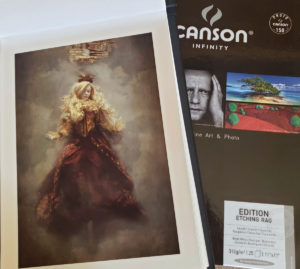
Fine Art Papers
Inkjet technology has come so far that the combination of pigment inks and 100% cotton coated inkjet papers, with no OBAs, now produce the highest resolution, most color accurate, archival, digital prints available. With my color managed workflow and excellent paper choices I am able to make museum quality prints in sizes from 4×6 inches to 44×66 inches on my Canon imagePROGRAF Pro-4100 printer at home.
Paper Choices
Paper choice is the most critical decision when it comes to directly affecting how your printed image will look. Nothing changes the look and feel of an image more than the paper it’s printed on. Choosing a paper is about expressing your unique artistic signature which is the combination of your paper choice along with your image to make your artwork unique to you. The best part of this process is that there is no wrong answer. You get to pick the paper you like. You get to create the art you want to and you get to decide which paper you love.
With well over 200 different types of inkjet papers to choose from, just the thought of paper choice can be overwhelming. As someone who understands the complexities of underwater photography, I will share with you my personal take on some of the very best paper choices.
Lustre Paper
For a paper that holds the widest color gamut and deepest blacks with the ability to showcase sharp edges and shadow details the very best paper I’ve ever experienced is Canson Infinity Platine Fibre Rag. It has a luster surface without being glossy, and a slight texture without so much texture as to distort details. It’s 100% cotton, no OBAs, and is widely considered one of the best archival, museum quality, fine art papers. I love the feel of the cotton on the back and the weight of it in my hands. It truly has all the qualities of a very special paper and there is nothing else like it on the market. Everything printed on it looks amazing but life would be boring if we all printed on the exact same paper and I don’t want to print all of my images on a luster paper.
Matte Paper
Some of my images are very specifically created for a matte paper. I had been using Canson Infinity’s Edition Etching but as with all 100% cotton matte papers, it is slightly warm. That warmth was just enough to subtly shift my blues to more of a green, a compromise I was willing to make as there were no alternatives – until now.
Canson Infinity and the historic Arches mill in France have introduced 3 historic papers with new inkjet emulsion technology that are just now coming out on the market (spring 2021) that I truly believe are perfect for underwater photography. They are 100% cotton, heavyweight, matte, bright white papers – with no optical brighteners. This is a game changer!
While underwater images come in all colors and levels of contrast and detail, having a pure white surface to print on leaves us with a print that is the most accurate representation of our colors the way we want them. No more color shifts or a warmth in our whites. These papers are a neutral blank slate for our images.
Arches 88 Pure White 310 gsm
Canson Infinity Arches 88 Rag is a legendary paper with a long history in printmaking. It’s really smooth and completely matte – there’s no sheen at all, even with Canson Infinity’s inkjet emulsion coating. It’s 100% cotton and pure white with no optical brighteners. This paper is perfect for photographers who want a really smooth matte neutral white paper.
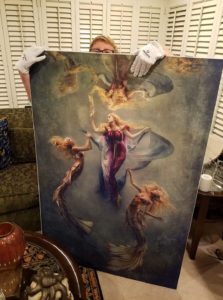 I’ve printed on it with images that are colorful, black and white, have deep blacks, and fine details and everything looks great on it. The surface is bright which makes my images pop off the page. Images look more dimensional not only in the contrast but color gradients as well.
I’ve printed on it with images that are colorful, black and white, have deep blacks, and fine details and everything looks great on it. The surface is bright which makes my images pop off the page. Images look more dimensional not only in the contrast but color gradients as well.
I know a lot of traditional photographers who are going to love this paper as it opens up a world of possibilities for printing our photographs. There’s been a great need for this paper so the fact that it’s here is really exciting.
Arches BFK Rives Pure White 310 gsm
Canson Infinity Arches BFK Rives is a very famous paper in the art world. It’s been used by artists for decades so it has a history and legacy – it’s not just a plain old piece of paper.
In photography it’s been used for traditional processes like palladium printing.
It’s got a beautiful subtle texture and thickness and weight so it feels substantial in the hand.
Canson Infinity offers it in its original state in a version called “White” which is actually a bit warm, but it’s the “Pure White” version that I love for my underwater images. This paper is now my alternative to Canson Infinity’s Edition Etching because I love the similar texture and the neutral white surface allows for colors that are more true to my original vision.
Arches Aquarelle Rag Pure White 310 gsm
Canson Infinity Arches Aquarelle Rag is a well known, historical watercolor paper used by painters. At the Arches Mill they use handmade felt blankets pressed into the surface of the 100% cotton paper pulp to create it’s recognizable and substantial watercolor texture. This newest version is pure white with no optical brighteners. I love the 100% cotton with its heavyweight feel and thickness along with the consistent quality of the distinctive Aquarelle textured surface. It’s my favorite paper for my images that have a lot of texture. I love the way that the texture in the paper plays nicely with the texture in the image.
This image went from being a digital picture on a computer monitor to a final piece of artwork with the unique characteristics of the paper texture, it’s thickness, weight and feel, as part of the finished photograph. The characteristics of the paper along with my image constitutes my unique artistic signature.
Fine Art Prints from the Lab
While I take immense pleasure from printing my own work, owning a printer is a responsibility that is not for everyone. There are plenty of small businesses and independent people who print for other photographers. An expert at a certified lab will know their papers inside and out and work with you to get the right paper for your image and your personal artistic look.
Professional Advice
Another option is having an “Inkjet Paper Psychotherapy Session” with my printing mentor Eric Joseph. It’s a very personalized process with an expert in the field of paper and printing listening to your wants and needs, offering education and advice in line with your work, printing your image of a variety of papers, mailing them to you and following up with a review session.
I truly hope that you consider all this information, along with my obvious personal bias and love of fine art paper prints. As underwater photographers I believe that our passion for what we do and the lengths we go to create our work makes us the most deserving of the best possible experiences with our artwork.
